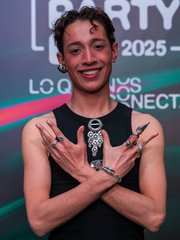ATHLETE
Erik Hægstad
1996 - Today

 Erik Hægstad
Erik Hægstad
Erik Hægstad (born 26 December 1996) is a Norwegian cross-country mountain biker, born in Drammen. He qualified to represent Norway at the 2020 Summer Olympics in Tokyo 2021, competing in men's cross-country. Read more on Wikipedia
His biography is available in 2 different languages on Wikipedia. Erik Hægstad is the 13,108th most popular athlete (down from 11,622nd in 2024), the 1,222nd most popular biography from Norway (down from 1,084th in 2019) and the 153rd most popular Norwegian Athlete.
Memorability Metrics
Page views of Erik Hægstad by language
Among ATHLETES
Among athletes, Erik Hægstad ranks 13,108 out of 6,025. Before him are Olivia Bergström, Andrey Potapkin, Ben Davison, Tal Erel, Kurtis Imrie, and David Liti. After him are Megan Hull, Georgia Nugent-O'Leary, Evan DePaul, Ben Preisner, Yao Bianwa, and María Moronta.
Most Popular Athletes in Wikipedia
Go to all RankingsOlivia Bergström
1996 - Present
HPI: 0.00
Rank: 13,537
Andrey Potapkin
1996 - Present
HPI: 0.00
Rank: 13,538
Ben Davison
1996 - Present
HPI: 0.00
Rank: 13,539
Tal Erel
1996 - Present
HPI: 0.00
Rank: 13,540
Kurtis Imrie
1996 - Present
HPI: 0.00
Rank: 13,541
David Liti
1996 - Present
HPI: 0.00
Rank: 13,542
Erik Hægstad
1996 - Present
HPI: 0.00
Rank: 13,543
Megan Hull
1996 - Present
HPI: 0.00
Rank: 13,544
Georgia Nugent-O'Leary
1996 - Present
HPI: 0.00
Rank: 13,545
Evan DePaul
1996 - Present
HPI: 0.00
Rank: 13,546
Ben Preisner
1996 - Present
HPI: 0.00
Rank: 13,547
Yao Bianwa
1996 - Present
HPI: 0.00
Rank: 13,548
María Moronta
1996 - Present
HPI: 0.00
Rank: 13,549
Contemporaries
Among people born in 1996, Erik Hægstad ranks 1,817. Before him are Varvara Baranova, Yao Bianwa, Andrey Potapkin, Alex Limberg, Olivia Bergström, and Katie Lund.
Others Born in 1996
Go to all RankingsVarvara Baranova
ATHLETE
1996 - Present
HPI: 0.00
Rank: 1,842
Yao Bianwa
ATHLETE
1996 - Present
HPI: 0.00
Rank: 1,843
Andrey Potapkin
ATHLETE
1996 - Present
HPI: 0.00
Rank: 1,844
Alex Limberg
ATHLETE
1996 - Present
HPI: 0.00
Rank: 1,845
Olivia Bergström
ATHLETE
1996 - Present
HPI: 0.00
Rank: 1,846
Katie Lund
SOCCER PLAYER
1996 - Present
HPI: 0.00
Rank: 1,847
Erik Hægstad
ATHLETE
1996 - Present
HPI: 0.00
Rank: 1,848
In Norway
Among people born in Norway, Erik Hægstad ranks 1,226 out of 1,039. Before him are Kyle Alessandro (2006), Sofus Heggemsnes (1999), Endre Funnemark (1998), Oscar Stabe Helvig (1995), Julie Erichsen (2001), and Martin Helseth (1994). After him are Lars Magne Ullvang (1994), Tonje Daffinrud (1991), Martine Steller Mortensen (1994), Therese Viklund (1987), and Ingeborg Løyning (2000).
Others born in Norway
Go to all RankingsKyle Alessandro
SINGER
2006 - Present
HPI: 2.63
Rank: 1,220
Sofus Heggemsnes
ATHLETE
1999 - Present
HPI: 2.54
Rank: 1,221
Endre Funnemark
ATHLETE
1998 - Present
HPI: 1.20
Rank: 1,222
Oscar Stabe Helvig
ATHLETE
1995 - Present
HPI: 0.00
Rank: 1,223
Julie Erichsen
ATHLETE
2001 - Present
HPI: 0.00
Rank: 1,224
Martin Helseth
ATHLETE
1994 - Present
HPI: 0.00
Rank: 1,225
Erik Hægstad
ATHLETE
1996 - Present
HPI: 0.00
Rank: 1,226
Lars Magne Ullvang
ATHLETE
1994 - Present
HPI: 0.00
Rank: 1,227
Tonje Daffinrud
ATHLETE
1991 - Present
HPI: 0.00
Rank: 1,228
Martine Steller Mortensen
ATHLETE
1994 - Present
HPI: 0.00
Rank: 1,229
Therese Viklund
ATHLETE
1987 - Present
HPI: 0.00
Rank: 1,230
Ingeborg Løyning
SWIMMER
2000 - Present
HPI: 0.00
Rank: 1,231
Among ATHLETES In Norway
Among athletes born in Norway, Erik Hægstad ranks 160. Before him are Martine Steller Mortensen (1994), Julie Erichsen (2001), Oscar Stabe Helvig (1995), Martin Helseth (1994), Lars Magne Ullvang (1994), and Tonje Daffinrud (1991). After him are Therese Viklund (1987).
Martine Steller Mortensen
1994 - Present
HPI: 0.00
Rank: 154
Julie Erichsen
2001 - Present
HPI: 0.00
Rank: 155
Oscar Stabe Helvig
1995 - Present
HPI: 0.00
Rank: 156
Martin Helseth
1994 - Present
HPI: 0.00
Rank: 157
Lars Magne Ullvang
1994 - Present
HPI: 0.00
Rank: 158
Tonje Daffinrud
1991 - Present
HPI: 0.00
Rank: 159
Erik Hægstad
1996 - Present
HPI: 0.00
Rank: 160
Therese Viklund
1987 - Present
HPI: 0.00
Rank: 161


























